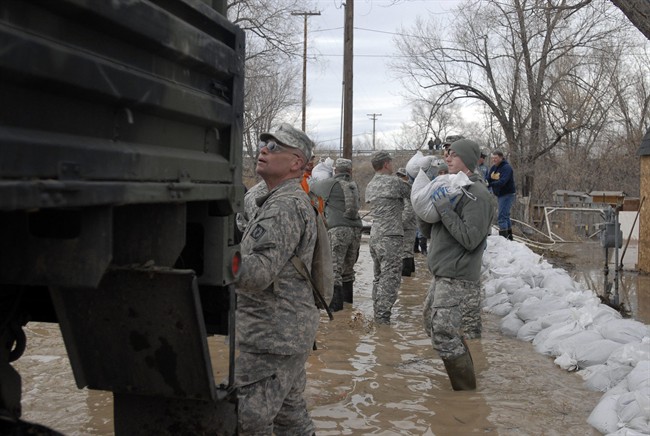BILLINGS, Mon. – Swollen rivers and impassable roads left hundreds of people cut off in rural areas of Montana on Monday, while in neighbouring Wyoming members of the National Guard joined the fight to protect two towns threatened by high water.

Authorities warned the flooding could get worse with more rain and snow expected early Tuesday.
Montana Gov. Steve Bullock declared a flood emergency late Monday after forecasters put 30 of the state’s 56 counties under some type of high water warning.
Musselshell County in central Montana appeared to be hardest hit: Dirt roads in rural areas turned to mud, some bridges were blocked by high water and the Musselshell River threatened to overcome protective dikes in Roundup.
Warm weather over the past week unleashed massive amounts of water from record snowfalls that have blanketed the region. That pushed many streams and rivers over their banks, authorities said.
Impassable roads cut off about 350 people south and east of Roundup, Musselshell County disaster co-ordinator Jeff Gates said.
Officials advised residents to stay in place if possible, and were crafting plans to ensure sufficient food and medical supplies were available to any stranded residents.
Hundreds more in the Dean Creek subdivision southwest of Roundup also were cut off for a time until the situation improved Monday evening. But officials advised residents to remain ready to leave if necessary.
- Trudeau says ‘good luck’ to Saskatchewan premier in carbon price spat
- Canadians more likely to eat food past best-before date. What are the risks?
- Hundreds mourn 16-year-old Halifax homicide victim: ‘The youth are feeling it’
- On the ‘frontline’: Toronto-area residents hiring security firms to fight auto theft
Temperatures were forecast to drop below freezing overnight as the rain turns to snow.
“If it freezes and we get snow the roads will freeze and it will help us,” Gates said.
In Wyoming, Guard members stacked up sand bags in Manderson and Greybull. The National Weather Service says sandbags were used to divert water around the Manderson school and water treatment plant. No evacuations were reported.
Seven homes were damaged in Greybull over the weekend but the extent of damage wasn’t immediately clear, said Wyoming Office of Homeland Security spokeswoman Kelly Ruiz. Video posted by the homeland security office showed the river full of ice chunks on Sunday and a home protected by sand bags surrounded by water.
Mountain snowpack across both states already is well above average, setting the stage for more high water when the spring runoff arrives. That’s expected in May or early June, said National Weather Service forecaster Chauncy Schultz.
Officials were keeping a wary eye on ice-jams along the Musselshell River west of Roundup, which has about 1,900 people. Ice jams also were reported on the Yellowstone, Big Horn and other rivers in Montana and Wyoming.
If the ice jams break free, water levels downstream could rise and more people in low-lying areas evacuated on short notice, Gates said. A makeshift dike in Roundup built after flooding three years ago was successfully holding back the water.
By late Monday, the Musselshell had risen to levels not seen since severe flooding damaged hundreds of homes in 2011.
More than two dozen houses near the Musselshell River were evacuated. Schools in Roundup were cancelled for Tuesday in anticipation that many teachers and students would not be able to make it.
The National Weather Service said a powerful Pacific storm system moving into the region would bring rain and wet snow through early Tuesday. More than an inch of precipitation was forecast in some areas.
Bullock’s emergency declaration allows the Democrat to mobilize state resources – including the National Guard if necessary – to help local authorities.
“We’re quite concerned about the moisture that’s going to drop in the Little Belt Mountains and the Snowy Mountains. That could add more issues along the Musselshell River and in Roundup,” said Steve Knecht, chief of operations for Montana Disaster and Emergency Services.
In Yellowstone County, high waters that flooded the basements of many homes were starting to dissipate, said county emergency services director Duane Winslow. Five homes south of Laurel remained evacuated.
A boil water order was in effect in Clyde Park north of Livingston, the Billings Gazette reported.
In the town of Manhattan, about 19 miles northwest of Bozeman, Mayor Dave Rowell said flooding in the downtown area late last week caused at least a million dollars in damages, television station KTVM reported.



Comments